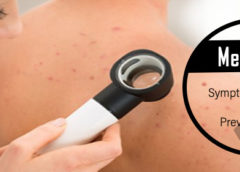Overview
Melanoma, the most severe form of skin cancer, grows in melanin-producing cells (melanocytes)—the pigment that gives the skin its colour. Melanoma can also grow within your eyes and, sometimes, within your body, including in your nose or neck.
The exact cause of all melanomas is not clear, but the risk of developing melanoma is increased by exposure to ultraviolet (UV) sunlight radiation or tanning lamps and beds. Limiting your UV radiation exposure will help reduce your melanoma risk.
The risk of melanoma in people under 40, particularly women, appears to be growing. Understanding the warning signs of skin cancer can help to detect and treat cancerous changes before the cancer has spread. Melanoma can be successfully treated if diagnosed early.
Symptoms
You can grow melanomas anywhere on your body. They grow more frequently in places that have been exposed to the such as your back, hands, arms and face.
Melanomas can also occur in areas, such as feet sole, hand palms, and fingernail beds, that do not receive much exposure to the sun. These hidden melanomas in darker skinned men are more common.
The first melanoma signs and symptoms often are:
- A change in an existing mole
- The development of a new pigmented or unusual-looking growth on your skin
Melanoma doesn’t always begin as a mole. It can also occur on otherwise normal-appearing skin
When to see a doctor
Make an appointment with your doctor if you notice any skin changes that seem unusual
Causes
Melanoma occurs when something goes wrong in the melanin-producing cells (melanocytes) that give color to your skin.
Skin cells usually grow in a regulated and organized way — healthy new cells drive older cells toward the surface of your skin, where they die and gradually fall off. So, when those cells cause damage to DNA, new cells can start to grow out of control and ultimately form a mass of cancerous cells.
Just what damages DNA in skin cells and how this leads to melanoma isn’t clear. It’s likely that a combination of factors, including environmental and genetic factors, causes melanoma. Still, doctors believe exposure to ultraviolet (UV) radiation from the sun and tanning lamps and beds is the leading cause of melanoma.
UV light does not cause all the melanomas, especially those that occur in places on your body that do not receive sunlight exposure. This indicates other factors may contribute to the melanoma risk.
Risk factors
Factors that may increase your risk of melanoma include:
- Fair skin: More pigment (melanin) in your skin means you have less protection against harmful UV radiation. When you have blond or red hair, light-colored skin, and easily freckles or sunburns, melanoma is more likely to grow than those with a darker complexion. But in people with darker complexions, like Hispanic people and Black people, melanoma can develop.
- A history of sunburn: One or more severe, blistering sunburns can increase your risk of melanoma.
- Excessive ultraviolet (UV) light exposure: Exposure to UV radiation from the sun and tanning lamps and beds can increase skin cancer risk like melanoma.
- Living closer to the equator or at a higher elevation: People living close to the equator of the Planet, where the rays of the Sun are more intense, receive higher levels of UV radiation than people living further north or south. Additionally, you’re exposed to more UV radiation if you live at a high elevation.
- Having many moles or unusual moles: Having more than 50 common moles on your body suggests a higher risk of melanoma. Finding an odd mole type raises melanoma risk, too. Medically known as dysplastic nevi, these appear to be larger than average moles with irregular boundaries and a combination of colors.
- A family history of melanoma: If a close relative — such as a parent, child or sibling — has had melanoma, you have a greater chance of developing a melanoma, too.
- Weakened immune system: The risk of melanoma and other skin cancers is increased for people with compromised immune systems. If you are taking medication to suppress the immune system, such as after an organ transplant, or if you have a disease that impairs the immune system, such as AIDS, the immune system can become impaired.
Prevention
If you: You will reduce the risk of melanoma and other skin cancer forms.
- Avoid the sun during the middle of the day: For many North American people, the sun’s rays are highest from around 10 a.m. And, at 4 p.m. For other periods of the day, plan outdoor activities, sometimes in winter or when the weather is gloomy.
You absorb UV radiation all year round, and clouds have no protection against harmful rays. Avoiding the best sun helps you avoid the sunburns and sunburns that cause skin damage and increase the skin cancer risk. Accumulated sun exposure over time can also cause skin cancer.
- Wear sunscreen year-round: Using a widescreen sunscreen of at least 30 SPE, also on rainy days. Apply sunscreen generously, and reapply every two hours — or more regularly, if you swim or suck.
- Avoid tanning lamps and beds: Tanning lamps and beds can emit UV rays, which can increase the risk of skin cancer.
Become familiar with your skin so that you’ll notice changes. Also check the skin for new growths of skin or improvements of existing moles, freckles, bumps and birthmarks. Check your face, arms, ears and scalp, using mirrors.
- Wear protective clothing: Protect your skin with dark, tightly knit clothes covering your arms and legs, and a wide-brimmed hat offering more protection than a baseball cap or viewfinder does.
Examine the tops and undersides of your arms and hands and your shoulders and neck. Examine your legs and feet both at the front and back, including the soles and gaps between the toes. Check the genital region and between the buttocks too.

Leave a Reply
You must be logged in to post a comment.